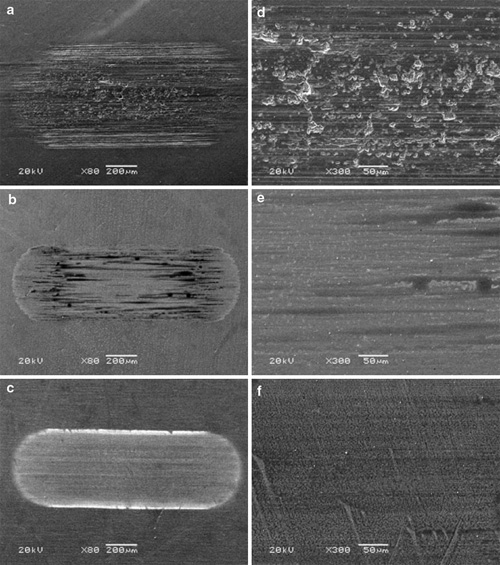Your Current Location is:Home > Research&Development
Novel Application of Ionic Liquid as Additive in Grease

SEM morphologies of the worn surfaces lubricated by polyurea grease and different additives: a, d polyurea grease; b, e 1 wt% T204; c, f 1 wt% LP106 (the magnification of the images on the left is 80 and that at the right is 300; load: 300 N, stroke: 1 mm, frequency: 25 Hz, duration: 30 min, temperature: 150℃) (LIU Weimin et al.)
Tribology Letters published a special issue on ionic liquid lubricants in November 2010, providing a glance of recent progress on the topic from world leading groups in the field. Prof. LIU Weimin from the Lanzhou Institute of Chemical Physics (LICP) of the CAS was invited to contribute a research paper on novel application of ILs as effective additive in grease. This is another important progress after the publication of the review paper on ionic liquid lubricants in ChemSocRev in 2009 by Prof. LIU’s group.
ILs as lubricants were firstly reported in 2001 by Prof. LIU’s group and have since become a hot topic in tribology society. Every year there are more than 50 papers published and patents issued. In 2009, the citations of IL lubricants have exceeded 900 times.
Previous research in this area focused on ILs as base oil, additive or as thin films, while the research on ILs as additive in grease was very rare. In Prof. LIU ’s paper, it is reported that ILs show good compatibility with polyurea grease, a high performance grease that can operate at high temperature and show excellent oxidation, thermal, mechanical, and colloidal stabilities. The application of 1 wt% additives in polyurea grease improved friction reduction and anti-wear properties at higher temperature than at room temperature for steel/steel contacts, and it showed better performance than zinc dialkyldithiophosphate (T204), a most widely used oil additive. This may be attributed to the high thermal stability, good solubility, better high temperature mobility and excellent tribological property of the ILs. The XPS analysis showed that complicated tribochemical reactions were involved in the friction process and that a surface protective film composed of FeF2, nitrides, and compound containing the P–O bonding were generated on the lubricated metal surface.
The work has received support from the National Basic Research Program of China, National Natural Science Foundation of China, and Chinese Academy of Sciences.
The findings have been published in Tribol. Lett. (Tribol. Lett. (2010) 40:215–224).